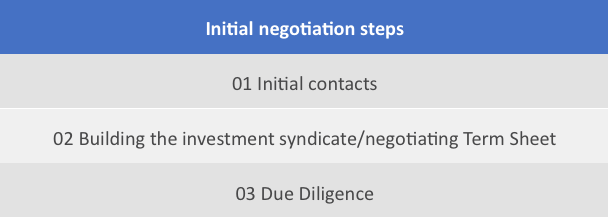23 Feb Negotiating a Round in the health sector (Part 2) The roadshow and the negotiation of the deal

- Pre-money valuation should be as high as possible in order to have an advantageous trading position.
- ahondar
- Some tools to mitigate the effects are preferential liquidation and the composition of the board of directors.
- There are other instruments such as drag along or phantom share plans
In the first article published in July we explained the three main phases of the negotiation of an investment round:

And we delved into the preliminary phase, which is the one corresponding to the preparation of the business plan and the preparation of the financial strategy. You can find all this information in the following (LINK).
This second opinion article focuses on the roadshow and all the phases necessary to complete the negotiation of the future deal.
To start the roadshow phase, we have to go back to Part 1 of the opinion article we published in mid-2022. In it, we saw how to work on each and every one of the key aspects to have a business plan and a deck for investors, which will become our most important tool for this phase. This deck, with the most representative slides to start the roadshow, will allow us to face with guarantees the success of the journey we will undertake in the negotiation of our investment round with venture capital.
The first thing to bear in mind is that the aspect that seems most important of all, the valuation of our company, is not as important as it seems. Evidently, valuation is very important, since if, for example, we are closing a 1 million euro round, and we set a pre-money valuation of 4 million euros, we are going to cede 20% of our company’s equity to the new investors. On the other hand, if we set the pre-money valuation at 1 million, we will give them no more and no less than 50%. The valuation is therefore extremely important. So much so that, in the second case, we will be compromising the governance of the company.
It is logical to think that, as entrepreneurs, what we must prioritize is a negotiation based on as high a pre-money valuation as possible. This is true, but we must consider the following:
- Investors, as we will see below, have other tools at their disposal to counteract the weight of a high valuation proposed by entrepreneurs.
- As entrepreneurs, it is in our interest that, in the next round we close after the one we are currently negotiating, there is an appropriate valuation jump. If the current valuation is too high, we will probably have trouble justifying a “market” valuation in the next round.
As we mentioned earlier, investors have control tools to mitigate the effects of an excessively high valuation proposed by the entrepreneurs. These mechanisms, which are numerous and could be the subject of more than one opinion piece, can be summarized in two:
- Economic mechanism: Preferential liquidation
- Governance mechanism: The composition of the company’s board of directors and reserved matters.
In the first case, preferential liquidation, investors will have a very powerful tool at their disposal when it comes to recovering their investment at the time of the exit scenario, i.e. the sale of the company or any liquidity event that enables investors to recover their investment, multiplied by a factor, by executing the business model that investors have as such.
Let’s imagine that we have been aggressive and have placed a valuation that is too high in the eyes of the investor, and that positions us in the high band or even out of the market. Let’s imagine, using the example above, that in our 1 million euro round we have set the valuation at 9 million pre-money, and therefore we give up 10% equity to the investors. Whereas, under normal conditions, the market valuation (in this fictitious example) is 4 million, which would result in 20% equity for the investors. At these two extremes, if the company reaches its liquidity event, and is sold for say 25 million (fictitious example), in the first case the investor would be entitled to 10% of 25 million, i.e. 2.5 million, resulting in a multiple of 2.5. In the other case, on the other hand, the investor would be entitled to twice as much, i.e. 5 million, and the multiple would be 5.
In the first case (equity 10%), the investor, to mitigate its low return, can apply a preferential liquidation with a specific multiple in the investment agreement. Let us imagine that the multiple is 2. This means that, in the event of liquidity, the investor first recovers 2 times the amount invested, and the remainder is distributed pro rata according to the equity. So, continuing with the example, if we sell for 25 million, the investor in the first case recovers 2 million and the remaining 23 million are distributed according to the equity, with the investor receiving 10% of 23 million, therefore 2.3 million, which added to the previous 2, makes a total of 4.3 million, and therefore its multiple is 4.3 and not 2. Taking this factor to the extreme, if we imagine a preferential liquidation with a factor of 5, the investor will recover 7 million, raising the factor from 2.5 to 7, a great business for them.
As entrepreneurs, we are not at all interested in preferential liquidation, and we can suggest to the investor, if he imposes it, the following counterproposal: set a cap above which the preferential liquidation does not apply. For example, that the company is sold for a minimum of X times the amount invested. In that case, the effect of the preferential liquidation will be lower, and the investor may agree to remove it from the investment agreement as long as this condition is met.
The other relevant aspect that the investor may impose on us in the negotiation, if we have been too aggressive in our valuation, is the composition of the board of directors and the list of reserved matters.
In normal situations, in a seed or even series A round, boards of directors may consist of 5 members. Of these, 2 will be proposed by the entrepreneurs, 2 will be proposed by the investors, and 1 will be an independent member that we can suggest from the entrepreneurial side, or at most by mutual agreement with the investors. In practice, we could say that we control slightly more than half of the votes on a board of directors. And reserved matters, with investor veto rights, will not be too restrictive under normal conditions.
On the other hand, if we negotiate too high a valuation, to counterbalance their low equity and therefore their low weight in decision-making, investors may impose more than 2 members, unbalancing the balance of the board and putting us in a clear minority, and may even suggest a broad list of reserved matters with veto rights, which will constrain us too much and clearly compromise the governance of the company and decision-making. In other words: we may have a high percentage of equity because we have been aggressive with a high valuation, but in practice we will not be able to make all the decisions that we should, and in the end the real control of the company will be in the hands of the investor. We must make sure that this does not happen.
As we have seen, and although there are many other tools that investors can use to their advantage when negotiating in situations of high valuations, if we have a high preferential liquidation and if we do not have control of the board of directors, we will not receive the economic return we deserve in the liquidity event, nor will we govern the company properly.
As we have discussed, there are many other keys that the investor can play in a negotiation if faced with an adverse scenario if the valuation is very high. In this opinion piece we have looked at preferential liquidation and the composition of the board of directors, but we could also talk about drag along, the phantom share plan and so on. All these aspects deserve to be dealt with in a separate opinion note later on.
Negotiating investment rounds is an art, we will find ourselves in the middle of a metastable equilibrium, with multiple variables to consider, and as entrepreneurs we will need to be well accompanied by consultants and professional law firms that can help us.
These lines are written from the experience accumulated in GENESIS Biomed, having closed 19 rounds of investment in the last 6 years, and having raised more than 67 million euros for our clients. Strategic consultancies like us play an essential role in the biomedical innovation sector, as we act as a facilitator and support element for our clients, entrepreneurs and institutions in the sector. With this second part we close this opinion article focused on the preparation and negotiation with investors. We hope you have found it useful. We are at your disposal to support you and help you in any way necessary through the company’s communication channels and social networks.


